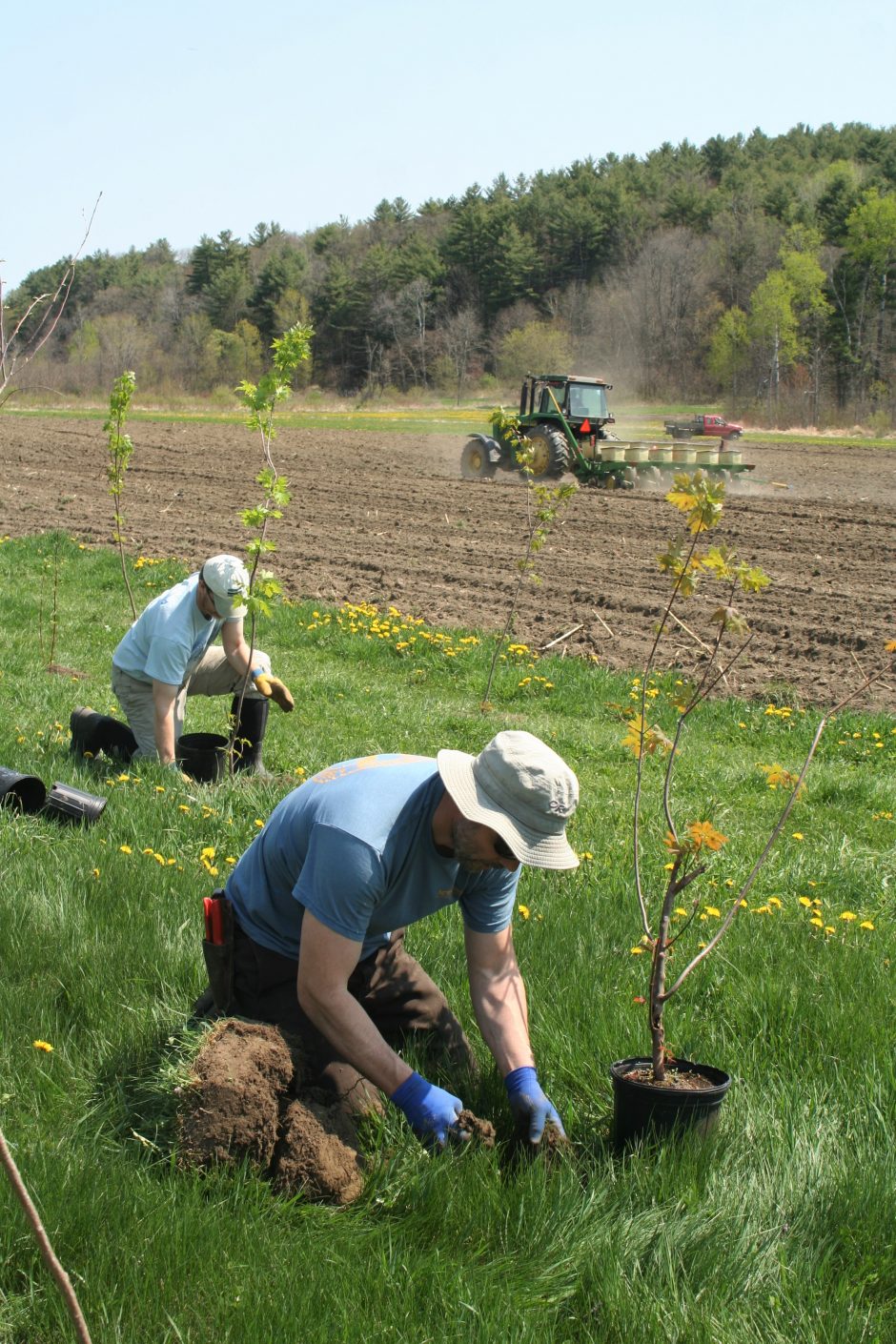Guardians of the Riverbank: Planting Trees to Protect Water Quality and Wildlife

Team members plant at Demers Haverhill NH location. (Credit: CRC)
In fall of 2017, the Connecticut River Conservancy (CRC) along with their project partners improved more than 9,000 feet of riverbank by planting 5,690 native trees and shrubs to protect the Connecticut River and its tributaries. The trees now guard against erosion and pollution on seven farms in New Hampshire and Vermont, and expand the existing habitat for local wildlife.
This kind of project is part of CRC’s core work. In August of 2011, Hurricane Irene roared up the East Coast of the United States, leaving a tell-tale path of destruction behind. Listed as the eighth-costliest hurricane in American history, the storm also hurt the watershed of the Connecticut River. Since that time, CRC has planted more than 23,000 native shrubs and trees in the watershed, helping local farmers, landowners, and agencies restore damaged areas and manage their water quality problems.
Tree-lined riverbanks
The 2017 planting project is a win-win for the environment and the community. Ron Rhodes, River Steward of the CRC, cites the benefits of planting trees along the river.
“Tree planting is the cheapest way to have real impacts on water quality and habitat for fish and wildlife,” Rhodes explains. “We pay $5 per tree and often use volunteers to help plant them, so project cost is pretty low compared to, say, a culvert replacement project where you are buying a bridge and paying a heavy equipment contractor.”
Although the CRC does not monitor for water quality, they do return to planting sites to check on progress, and replant should deadloss occur.
Our projects generally do not require maintenance, unless there are problems with aggressive competitors, field bindweed for example, flooding, or ice scour,” adds conservation scientist Fritz Gerhardt, who partners with CRC on most of their planting projects.
The science behind the planting
Trees are critically important to the ecosystem generally, not least as oxygen-producers and carbon dioxide capturers, cleaning pollution from the air. However, they also provide a number of specific benefits in their role as riparian buffers. They slow runoff from rainwater, reducing erosion, flooding, and pollution. This also helps recharge aquifers, encouraging more water back into the ground.

Luke O’Brien (NorthWoods Stewardship Center) planting at the Simpson Farm in Lisbon NH. (Credit: CRC)
Trees lining riverbanks are themselves habitats for birds and forest wildlife. However, they also protect fish habitats, keeping rivers cooler and preventing overgrowth of bacteria and algae that thrive in warmer waters. Additionally, trees along the river help ensure the river can be enjoyed by local communities, which rely upon the watershed for boating, fishing, swimming, and other recreational opportunities—one reason for the program’s popularity.
“Farmers, towns and other landowners love it,” details Rhodes. “They get free trees and we take care of all the paperwork, scheduling and planting. I’ve never had a complaint from a willing landowner, although there have been farmers who decided not to move forward with a planting because they felt they couldn’t lose the hay field, corn, et cetera.”
Gerhardt describes how the team works to re-establish floodplain forests through their various projects.
“We use science to inform and evaluate our restoration projects, which include floodplain forest and riparian buffer restoration,” explains Gerhardt. “In developing our planting plans for any site, we survey the existing vegetation at or near the site to be planted, and we also evaluate the habitat characteristics of the site, so that we can plant the appropriate species that likely would have been found on that site prior to European settlement. Thus, for example, a floodplain site along a large, meandering river may flood frequently, one to three times per year, and will be characterized by silt loam or fine sandy loam soils. At such sites, we plant species such as silver maple, eastern cottonwood, black willow, American basswood, common elderberry, highbush cranberry, red-osier dogwood, shrub willows, and speckled alder.”
Once the team has established these macro level details, they consider the finer points as they select sites for each new plant.
“Within each restoration site, we also plant our species in the appropriate microhabitats that offer the appropriate site conditions,” Gerhardt describes. “For example, we will often plant American basswood and even sugar maple at slightly higher elevations on the floodplain, and silver maple at lower and moderate elevations, because silver maple tolerates flooding for longer time periods and greater water depths than these other two species.”
CRC is careful to select only native species, and they also strive to purchase planting stock locally. This isn’t just a progressive business practice; it helps ensure that planting stock is already adapted to local conditions, and is part of the local gene pool. Especially where competition from non-native grasses is fierce, the team plants larger stock, typically 4- to 6-feet for trees and 3- to 4-feet for shrubs.
The program enjoys broad support in the local communities it serves, and the public largely recognizes the benefits that are coming from these projects. This is one of the most important factors behind the CRC’s success with the program.
“Everybody should plant a tree,” Rhodes asserts. “I’ve done it around my pond. Local conservation districts sell plants. It is easy. Kids and students love helping plant trees. It is a feel good and do good story on all ends.”

Alex Kirk of the NorthWoods Stewardship Center plants a tree in Demers Haverhill NH. (Credit: CRC)
Top image: Ron Rhodes (Connecticut River Conservancy) and Luke O’Brien (NorthWoods Stewardship Center). (Credit: CRC)




Kelvin Kamayoyo
September 29, 2023 at 12:54 am
I love this article and we want to work with you in Africa to plant 10million trees from Cape Town in South Africa to Cairo Egypt.